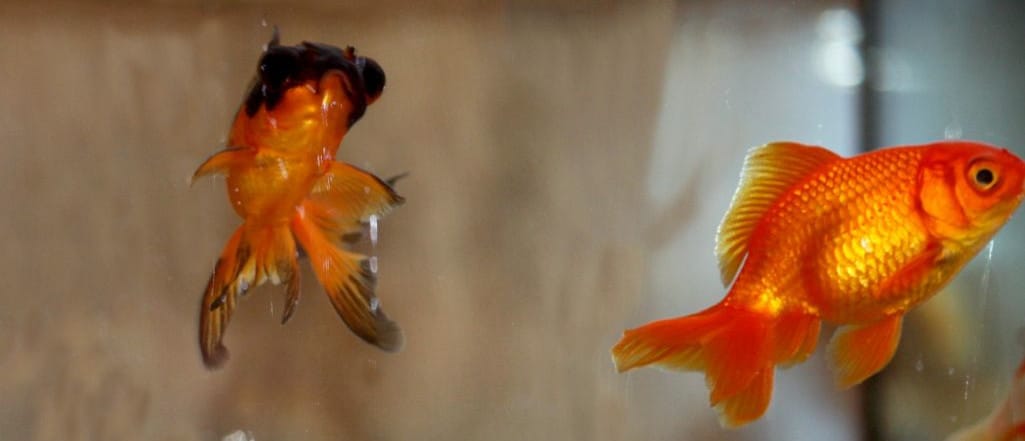Why Is My Goldfish Turning Black? All Answers Here
Goldfish are renowned as a much beloved pet that are also relatively easy to take care of. This is one of the characteristics that makes them so popular with relative amateurs and experienced hobbyists alike.
There is little doubt that so long as you take care of your goldfish properly, which means maintaining their environment, giving them a balanced diet and ensuring the water chemistry is right, then you can expect your goldfish to live happily for many years.
However, if you fail to take proper care of your goldfish, then there are a number of bad things that can happen.
In normal circumstances goldfish can add a lot of color and liveliness to your take. They are well known for their playful and lively personalities, which can add interest to any home fish tank. They are also sure to be aesthetically pleasing, because they can display very vibrant colors from green to blue to orange or red.
However, one nightmare scenario that befalls many goldfish owners is that the goldfish can start to turn black.
Not only does this ruin the aesthetics of your tank, but it is likely to cause most owners to stress and worry about the health of their fish. For that reason, it is important to explore ‘why is my goldfish turning black’ and what you can do about it.
Table of Contents
The Basics
There are a number of potential reasons for this affliction happening to your goldfish, but before we delve into this problem it is important to understand some of the background. Firstly, goldfish are domesticated fish which have been bred, mainly in China, for thousands of years.
They are related to carp in the wild, but selective breeding over the centuries has led to them developing their own specific characteristics. They are a freshwater fish which can do well in cold water conditions, and they can live for a long time (over 10 years) and grow to over 12 inches in size if the space permits.
They have also been specially bred to display a wide variety of different colors and shapes, and they are often complimented for their range of gorgeous, vivid hues. This is one of the reasons why blackening of the skin can be so upsetting to any self-respecting goldfish owner.
It might not be a problem at all
The first thing to realize is that, although it may seem strange, this might be a wholly natural process that just happens as your goldfish grows and develops.
As was eluded to before, goldfish have been bred for every type of color variation and genetic difference under the sun. As a result, in some rare types of goldfish, they may be genetically programmed, or predetermined, to turn black as they grow older.
This could be a defense mechanism or may be a byproduct of a breeding process. In any case, in these circumstances it is not something that you should worry about, and it is not something that you can reverse, even if you are worried!
It is best to thoroughly research exactly what kind of goldfish you have, and if required you should consult a reputable source or ask an expert. They should be able to tell you whether this is a natural process in your specific type of goldfish, or indeed, if it is more sinister.
Black Moor Goldfish Care (Black Telescope)
Ammonia Burns
Video: “Ammonia Poisoning and Burns | What the fish is Ammonia? How to Treat and Prevent its Side Affects .”
Unfortunately, if it is not a natural process, then it is most likely related to a buildup of pernicious ammonia in the water. This can cause all sorts of knock on health effects to aquatic creatures and causes great general damage to the ecosystem.
Ammonia is a natural waste product produced by fish. In small concentrations it is relatively harmless, but if the levels rise too high then it can damage fish health and general well-being. In normal circumstances, and where a tank is sufficiently filtered and clean, the ammonia level is kept in check by positive bacteria in the water.
Good Bacteria
These ‘good’ bacteria clump together to form colonies and they are an essential part of the nitrogen cycle.
During this vital process, the bacteria feast on the harmful waste products such as ammonia and nitrates and break them down into harmless substances such as nitrites. This nitrogen cycle helps to keep the ecosystem in equilibrium, but it can take a few days or even weeks to establish in your tank.
Excess ammonia can turn your goldfish’s skin black.
Ammonia levels in your tank might become elevated for any number of reasons. The most likely cause is that the population of ‘good’ bacteria in the tank has been depleted for some reason, so the rate of ammonia reduction has dropped.
To restore balance in your tank, and hopefully return your goldfish to its natural color, you should try and increase the level of biological filtration in your tank.
You can do this by installing a filter canister, or just adding simple devices like bio balls or ceramic rings. Bacteria colonies love to thrive in these areas, and hopefully this should give your tank more filtration capacity and get rid of the problem of blackness in your fish.
Parasites
One of the common worries when people ask themselves, ‘why is my goldfish turning black’ is that they may have contracted an infection due to parasites. Unfortunately, this theory cannot be discounted.
Parasites may burrow themselves into the skin of your goldfish, and this may cause them to blacken or scorch the skin to an unhealthy shade. Parasites may enter the tank by a number of routes. This includes any source of exposure with the outside world, especially through live feeding or by water snails in your tank. Water snails should be obvious in your tank, either latched to the glass or the substrate of the tank.
If you simply remove these critters you should have a positive impact on the condition of your tank. This problem is also known as black spot disease, and it is relatively rare in adult fish. The black color is actually a result of the fish’s own defensive mechanism.
As the parasites bury their heads under the skin of the goldfish, the victims will tend to produce cysts on their skin to harden the surface and prevent more incursions. This is what gives the skin its definitive black appearance.
[amazon box=”B004LOBGYA”]
You need to be very careful to control parasites in your tank, because in such close quarters they can spread quickly and cause a lot of damage to the ecosystem. If you manage to remove the affecting parasites, either by manual or chemical means, then you should notice that the goldfish should slowly return to its natural color. If not, then you might want to consult a vet.
Prevention

As the old saying goes, prevention is better than cure. There are a number of simple steps that you as a pet owner should take to make sure your beloved goldfish retains its natural luster and hue for its whole life.
First and foremost is regular cleaning. This is good practice anyways, but it also helps to keep ammonia levels in your tank low and thus prevent blackening
A thorough regular maintenance routine should include water changes in your tank as well as gentle cleaning of the biological filters in your tank. You should make sure not to over handle these items as the good bacteria colonies are very sensitive and are easily damaged. You should also be sure to clean the tank walls, substrate and any ornaments you may have placed in the tank.
Overfeeding
To prevent an explosion of ammonia in your tank one of the most effective measures you can do is to not overfeed your fish.
Overfeeding can cause huge, irreparable damage as the uneaten food sinks to the bottom of the tank and releases all its nutrients into the water. This can lead to a huge spike in ammonia and destroy the chemical balance in your tank. On top of that, there can be knock on effects such as algae blooms, which can be just as serious.
On general it is recommended that you feed your goldfish no more than they can consume in two or three minutes, and you remove all uneaten food at the end of the feeding session.
Top 7 Best Goldfish Food Brands – Feeding Guide & Review
Conclusion
Hopefully this comprehensive article has answered the question, ‘why is my goldfish turning black?’.
Remember there are very good natural reasons why this may be the case, as some goldfish blacken later in life due to genetics. However, if it is not a permanent, natural change, then it most likely indicates an underlying problem.
In rare cases this may be because of parasites in the water, usually coming from water snails. However, more often this is as a result of burns caused by excessive amounts of ammonia in the water.
This problem can be tackled in the usual way, by a thorough cleaning regime, frequent water changes, and most importantly, by installing enough biological filtration capacity in your tank. This should leave you in no doubt as to why is my goldfish turning black?




